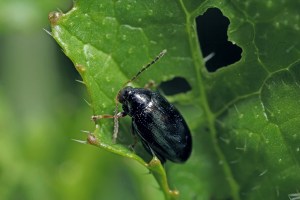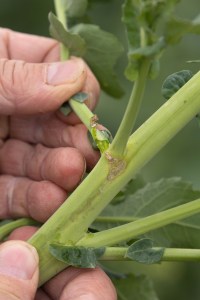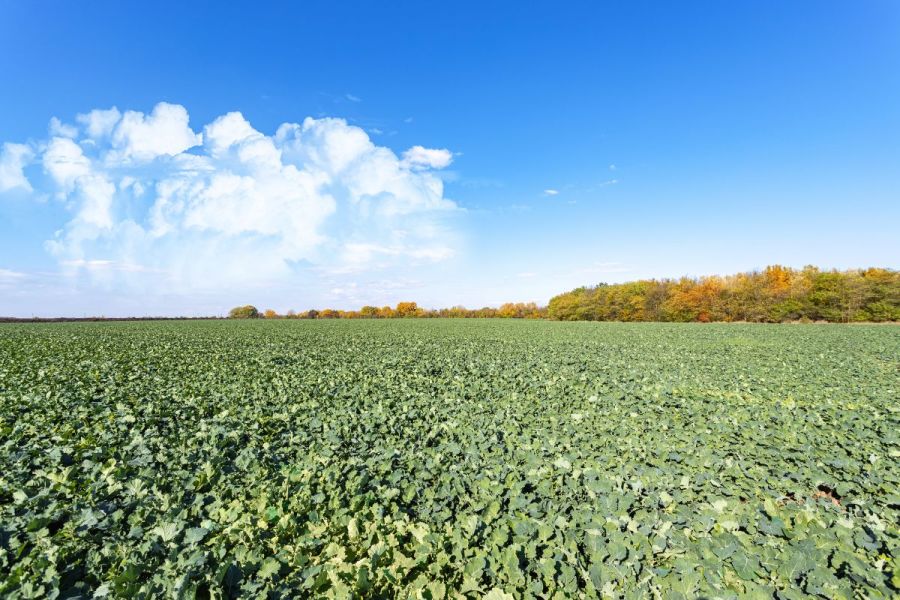It might appear the challenge of cabbage stem flea beetle is insurmountable, but the industry has not sat on its laurels since losing neonicotinoids. CPM gets the scoop on the latest results from NIAB’s csfbSmart project.
“Based on what we have seen so far, volunteers don’t act as a trap crop in anyway.”
By Melanie Jenkins
Growers could well be resigned to the fact that cabbage stem flea beetle is a problem that’s here to stay and that in some years it will cause large losses and in others it won’t. But at part of the csfbSmart initiative, the NIAB-led project, which is funded by Defra, has been looking at practical ways to keep this most nuisance of pests from damaging OSR crops, driven by farmer led involvement.

Results from the csfbSMART project show that the geographical spread of CSFB has widened across the country.
And based on stem samples sent to NIAB from growers in 2021, the geographical spread of CSFB has widened across the country, with the pest now found north of Berwick-upon-Tweed and in higher numbers in North Wales than previously witnessed. “It’s not just in the home counties anymore, but has spread much further,” says Colin Peters of NIAB.
One of the big headaches with CSFB is its larvae, which may be found in stems and petioles of plants. Three years ago, a large chunk of the crop was lost after Christmas because of this, says Colin. “This is still causing difficulties now and growers have asked, ‘if I get my crop established, how am I going to help get it to fruition’.”
During the 2019/20 season, NIAB picked out some differences in adult CSFB preference towards certain OSR varieties in small plot trials, explains Colin. “There appeared to be some favoured movement of adults when they were laying eggs.”
To test this, NIAB looked at three different varieties (based on informed discussion about in field CSFB behaviour) grown as monocrops in 24x24m plots. “We also drilled 80:20 splits of the varieties but at 90˚ to one another so as to easily pick the different varieties for stem sampling at two Cambridgeshire sites.”

Longer lasting companion crops are thought to mask OSR crops from CSFB adults looking to lay eggs, says Colin Peters.
The varieties used were Aspire, Aurelia and DK Expectation. “Aspire picked up the least stem larvae in both situations, followed by Aurelia and then Expectation. But there was no statistical difference between Aurelia and Expectation at all, and Aspire might only have had the least larvae because it emerges more slowly.
“In the control plots based in Cambridge and Dorset, there was a difference in larval numbers but when we tried to integrate the different varieties into a blend with the aim of using one variety to take the higher burden, there clearly was no difference,” he explains.
“It was a very exciting idea but, unfortunately, when we looked at these varieties there was no difference at all so this won’t be something we will be following up on,” says Colin.
Another investigation NIAB has undertaken has involved looking at longer lasting companion crops which are thought to work by masking OSR crops from CSFB adults looking to lay eggs or feed on young plants through the late autumn and winter period.
It does appear that there’s a reduction in stem larvae where longer lasting companion crops are grown, says Colin. “This fits with what we’re seeing with the emergence data. We’re looking to sample as many crops as we can this winter that have later lasting companion crops such as vetches, beans, phacelia and are happy to visit any farmers that have such crops to sample and provide information that may help their management moving forwards.”
And diversity of companion crops may play a role in deterring CSFB adults from OSR plants. “We noticed that where a grower had a wide mix of companion crops there was a significant reduction in stem larvae, which we can only assume is due to the crop being masked at the time the adults were flying around looking for it.”
But what has the project learnt about adult movements? In 2021, NIAB used water traps in volunteers next to emerging OSR crops to assess whether these can act as trap crops, which is one of ideas which has seemed promising in previous ADAS research.
“We hardly saw any CSFB in these traps, so it looks as if the adults are emerging from August through to November and leaving the field,” says Colin. “But we’re well aware that many insects are programmed to leave the site they emerge from to go and populate other areas.”
The 2022 season was unique in that the hot, dry summer and early autumn meant volunteers were only just emerging in September, but again, none of these showed any CSFB damage, adds Colin. “So that rubber stamps it. We do have to be careful as this is only one year’s worth of data, but based on what we have seen so far, volunteers don’t act as a trap crop in anyway.”

The csfbSmart project looked at whether CSFB had a preference towards one OSR variety over another.
A further idea NIAB is investigating looks at the concept that the pest may have a vulnerable stage in August when pupae are in the soil, and that could be taken advantage of through the use of shallow cultivations. It’s a similar strategy to one being employed to reduce wireworm in arable soils, says Colin.
“We had two farmers carry out different depth cultivations on their farms, with traps placed in both cultivated and uncultivated fields. The first farm’s cultivated fields demonstrated a 68% reduction in CSFB emergence to the end of September,” says Colin. “The pests started to catch up a bit, so by the end of November this dropped to a 63% reduction. This intimates that this window of vulnerability exists.”
At the second farm, which had slightly deeper cultivations, there was a 93.7% reduction in emergence to the end of September, which fell to 90% by the end of November. “These cultivations were done straight after harvest and didn’t affect the emergence of volunteers, so the fields still greened up nicely. We think this is quite exciting and we will hopefully look at this in more detail by taking core samples of soil to understand what’s going on with the larvae.”
To help further its investigations, NIAB requests any growers who still have living companion crops with their OSR to get in touch as it would be interested in taking samples.
This article was taken from the latest issue of CPM. For more articles like this, subscribe here.




